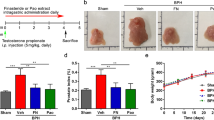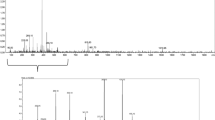Summary
Extracts from Pygeum africanum are used in the treatment of prostatitis, benign prostatic hyperplasia (BPH) and prostate cancer (PCa). The ligand-activated human androgen receptor (AR) is known to control the growth of the prostate gland. Inhibition of human AR is therefore a major goal in treatment of patients. Here, we characterize the compound N-butylbenzene-sulfonamide (NBBS) isolated from P. africanum as a specific AR antagonist. This antihormonal activity inhibits AR- and progesterone receptor- (PR) mediated transactivation, but not the related human glucocorticoid receptor (GR) or the estrogen receptors (ERα or ERβ). Importantly, NBBS inhibits both endogenous PSA expression and growth of human PCa cells. Mechanistically, NBBS binds to AR and inhibits its translocation to the cell nucleus. Furthermore, using a battery of chemically synthesized derivatives of NBBS we revealed important structural aspects for androgen antagonism and have identified more potent AR antagonistic compounds. Our data suggest that NBBS is one of the active compounds of P. africanum bark and may serve as a naturally occurring, novel therapeutic agent for treatment of prostatic diseases. Thus, NBBS and its derivatives may serve as novel chemical platform for treatment prostatitis, BPH and PCa.








Similar content being viewed by others
Abbreviations
- AR:
-
Human androgen receptor
- BPH:
-
Benign prostate hyperplasia
- CPA:
-
Cyproterone acetate
- C4-2:
-
a LNCaP derivative cell line that exhibits androgen-independent growth
- CV1:
-
Kidney cell line from green monkey, lacking endogenously expressed functional AR, GR, ER, PR and TR
- DHT:
-
Dihydrotestosterone, androgen agonist
- E2:
-
Estradiol
- ER:
-
Human estrogen receptor
- GAPDH:
-
Glyceraldehyde-3-phosphate dehydrogenase
- GFP:
-
Green fluorescent protein
- GR:
-
Human glucocorticoid receptor
- HBD:
-
Hormone binding domain
- LNCaP:
-
a human prostate cancer cell line, exhibits hormone-dependent growth
- LacZ:
-
β-galactosidase expression vector used for normalization of transfection efficiency
- Luc:
-
Luciferase
- MMTV:
-
Mouse mammary tumor virus
- NBBS:
-
N-butylbenzene-sulfonamide
- OH-F:
-
Hydroxyflutamide, androgen antagonist
- PCa:
-
Prostate cancer
- PC3:
-
a human prostate cancer cell line, lacking endogenously expressed functional AR
- PC3-ARwt:
-
stable transfected PC3 cell line, expressing human wild type AR
- PSA:
-
Prostate specific antigen
- PR:
-
Human progesterone receptor
- qRT-PCR:
-
Real time reverse transcription polymerase chain reaction
- R1881:
-
Methyltrienolone, androgen agonist
- RLU:
-
Relative light units (normalized to internal control)
- T3:
-
Thyroid hormone (3,5,3′-triiodothyronine)
- TR:
-
Thyroid hormone receptor
- (DR4)2 :
-
Two direct repeats as known TR response elements
References
Jemal A, Siegel R, Ward E, Murray T, Xu J, Thun MJ (2007) Cancer statistics. CA Cancer J Clin 57(1):43–66
Shah US, Getzenberg RH (2004) Fingerprinting the diseased prostate: associations between BPH and prostate cancer. J Cell Biochem 91:161–169
Levin RM, Das AK (2000) A scientific basis for the therapeutic effects of Pygeum africanum and Serenoa repens. Urol Res 28:201–209
Dehm SM, Tindall DJ (2006) Molecular regulation of androgen action in prostate cancer. J Cell Biochem 99:333–44
Dehm SM, Tindall DJ (2007) Androgen receptor structural and functional elements: role and regulation in prostate cancer. Mol Endocrinol 21(12):2855–63
Chen S, Xu Y, Yuan X, Bubley GJ, Balk SP (2006) Androgen receptor phosphorylation and stabilization in prostate cancer by cyclin-dependent kinase 1. Proc Natl Acad Sci U S A 103:15969–74
Tindall DJ (2007) Pursuing the androgen pathway on the quest to control prostate cancer. Cancer Biol Ther 6
Taplin ME (2007) Drug insight: role of the androgen receptor in the development and progression of prostate cancer. Nat Clin Pract Oncol 4(4):236–44
Balk SP, Knudsen KE (2008) AR, the cell cycle, and prostate cancer. Nucl Recept Signal 6:e001
Dehm SM, Regan KM, Schmidt LJ, Tindall DJ (2007) Selective role of an NH2-terminal WxxLF motif for aberrant androgen receptor activation in androgen depletion independent prostate cancer cells. Cancer Res 67(20):10067–77
Taplin ME, Bubley GJ, Ko YJ, Small EJ, Upton M, Rajeshkumar B, Balk SP (1999) Selection for androgen receptor mutations in prostate cancers treated with androgen antagonist. Cancer Res 59:2511–5
Zhao XY, Malloy PJ, Krishnan AV, Swami S, Navone NM, Peehl DM, Feldman D (2000) Glucocorticoids can promote androgen-independent growth of prostate cancer cells through a mutated androgen receptor. Nat Med 6:703–6
Veldscholte J, Berrevoets CA, Brinkmann AO, Grootegoed JA, Mulder E (1992) Anti-androgens and the mutated androgen receptor of LNCaP cells: differential effects on binding affinity, heat-shock protein interaction, and transcription activation. Biochemistry 31(8):2393–9
Berrevoets CA, Veldscholte J, Mulder E (1993) Effects of antiandrogens on transformation and transcription activation of wild-type and mutated (LNCaP) androgen receptors. J Steroid Biochem Mol Biol 46(6):731–6
Culig Z, Hoffmann J, Erdel M, Eder IE, Hobisch A, Hittmair A, Bartsch G, Utermann G, Schneider MR, Parczyk K, Klocker H (1999) Switch from antagonist to agonist of the androgen receptor bicalutamide is associated with prostate tumour progression in a new model system. Br J Cancer 81:242–51
Buck AC (2004) Is there a scientific basis for the therapeutic effects of serenoa repens in benign prostatic hyperplasia? Mechanisms of action. J Urol 172:1792–9
Wilt T, Ishani A, Mac Donald R, Rutks I, Stark G (2002) Pygeum africanum for benign prostatic hyperplasia. Cochrane Database Syst Rev (1):CD001044
Bombardelli E, Morazzoni P (1997) Prunus Africana (Hook. f.). Kalkm Fitoterapia 68:205–218
Yoshimura Y, Yamaguchi O, Bellamy F, Constantinou CE (2003) Effect of Pygeum africanum tadenan on micturition and prostate growth of the rat secondary to coadministered treatment and post-treatment with dihydrotestosterone. Urology 61:474–8
Schleich S, Papaioannou M, Baniahmad A, Matusch R (2006) Extracts from Pygeum africanum and other ethnobotanical species with antiandrogenic activity. Planta Med 72(9):807–13
Gast A, Schneikert J, Cato AC (1998) N-terminal sequences of the human androgen receptor in DNA binding and transrepressing functions. J Steroid Biochem Mol Biol 65:117–123
Dotzlaw H, Moehren U, Mink S, Cato AC, Iniguez Lluhi JA, Baniahmad A (2002) The amino terminus of the human AR is target for corepressor action and antihormone agonism. Mol Endocrinol 16:661–673
Leers J, Steiner C, Renkawitz R, Muller M (1994) A thyroid hormone receptor-dependent glucocorticoid induction. Mol Endocrinol 8:440–7
Schulz M, Eggert M, Baniahmad A, Dostert A, Heinzel T, Renkawitz R (2002) RU486-induced glucocorticoid receptor agonism is controlled by the receptor N terminus and by corepressor binding. J Biol Chem 277:26238–43
Baniahmad A, Tsai SY, O’Malley BW, Tsai MJ (1992) Kindred S thyroid hormone receptor is an active and constitutive silencer and a repressor for thyroid hormone and retinoic acid responses. Proc Natl Acad Sci U S A 89:10633–7
Dotzlaw H, Papaioannou M, Moehren U, Claessens F, Baniahmad A (2003) Agonist-antagonist induced coactivator and corepressor interplay on the human androgen receptor. Mol Cell Endocrinol 213:79–85
Protopopov AI, Li J, Winberg G, Gizatullin RZ, Kashuba VI, Klein G, Zabarovsky ER (2002) Human cell lines engineered for tetracycline-regulated expression of tumor suppressor candidate genes from a frequently affected chromosomal region, 3p21. J Gene Med 4:397–406
Peterziel H, Mink S, Schonert A, Becker M, Klocker H, Cato AC (1999) Rapid signalling by androgen receptor in prostate cancer cells. Oncogene 18(46):6322–9
Thalmann GN, Anezinis PE, Chang SM, Zhau HE, Kim EE, Hopwood VL, Pathak S, von Eschenbach AC, Chung LW (1994) Androgen-independent cancer progression and bone metastasis in the LNCaP model of human prostate cancer. Cancer Res 54:2577–2581
Tanner TM, Verrijdt G, Rombauts W, Louw A, Hapgood JP, Claessens F (2003) Anti-androgenic properties of Compound A, an analog of a non-steroidal plant compound. Mol Cell Endocrinol 201(1–2):155–64
Papaioannou M, Schleich S, Prade I, Degen S, Roell D, Schubert U, Tanner T, Claessens F, Matusch R, Baniahmad A (2008) The natural compound atraric acid is an antagonist of the human androgen receptor inhibiting cellular invasiveness and prostate cancer cell growth. J Cell Mol Med ahead of publication, in press
Negri-Cesi P, Motta M (1994) Androgen metabolism in the human prostatic cancer cell line LNCaP. J Steroid Biochem Mol Biol 51:89–96
Fedoruk MN, Gimenez-Bonafe P, Guns ES, Mayer LD, Nelson CC (2004) P-glycoprotein increases the efflux of the androgen dihydrotestosterone and reduces androgen responsive gene activity in prostate tumor cells. Prostate 59:77–90
Alen P, Claessens F, Verhoeven G, Rombauts W, Peeters B (1999) The androgen receptor amino-terminal domain plays a key role in p160 coactivator-stimulated gene transcription. Mol Cell Biol 19(9):6085–97
Bevan CL, Hoare S, Claessens F, Heery DM, Parker MG (1999) The AF1 and AF2 domains of the androgen receptor interact with distinct regions of SRC1. Mol Cell Biol 19(12):8383–92
Liao G, Chen LY, Zhang A, Godavarthy A, Xia F, Ghosh JC, Li H, Chen JD (2003) Regulation of androgen receptor activity by the nuclear receptor corepressor SMRT. J Biol Chem 278(7):5052–61
Shang Y, Myers M, Brown M (2002) Formation of the androgen receptor transcription complex. Mol Cell 9:601–10
Kang Z, Jänne OA, Palvimo JJ (2004) Coregulator recruitment and histone modifications in transcriptional regulation by the androgen receptor. Mol Endocrinol 18(11):2633–48
Hodgson MC, Astapova I, Cheng S, Lee LJ, Verhoeven MC, Choi E, Balk SP, Hollenberg AN (2005) The androgen receptor recruits nuclear receptor CoRepressor (N-CoR) in the presence of mifepristone via its N and C termini revealing a novel molecular mechanism for androgen receptor antagonists. J Biol Chem 280(8):6511–9
Moehren U, Papaioannou M, Reeb CA, Hong W, Baniahmad A (2007) Alien interacts with the human androgen receptor and inhibits prostate cancer cell growth. Mol Endocrinol 21:1039–48
Kiviharju TM, Lecane PS, Sellers RG, Peehl DM (2002) Antiproliferative and proapoptotic activities of triptolide (PG490), a natural product entering clinical trials, on primary cultures of human prostatic epithelial cells. Clin Cancer Res 8:2666–74
Rosenberg Zand RS, Jenkins DJ, Brown TJ, Diamandis EP (2002) Flavonoids can block PSA production by breast and prostate cancer cell lines. Clin Chim Acta 317:17–26
Xing N, Chen Y, Mitchell SH, Young CY (2001) Quercetin inhibits the expression and function of the androgen receptor in LNCaP prostate cancer cells. Carcinogenesis 22:409–14
Zi X, Agarwal R (1999) Silibinin decreases prostate-specific antigen with cell growth inhibition via G1 arrest, leading to differentiation of prostate carcinoma cells: implications for prostate cancer intervention. Proc Natl Acad Sci U S A 96:7490–5
Zi X, Zhang J, Agarwal R, Pollak M (2000) Silibinin up-regulates insulin-like growth factor-binding protein 3 expression and inhibits proliferation of androgen-independent prostate cancer cells. Cancer Res 60:5617–20
Thelen P, Jarry H, Ringert RH, Wuttke W (2004) Silibinin down-regulates prostate epithelium-derived Ets transcription factor in LNCaP prostate cancer cells. Planta Med 70:397–400
Hong CY, Gong EY, Kim K, Suh JH, Ko HM, Lee HJ, Choi HS, Lee K (2005) Modulation of the expression and transactivation of androgen receptor by the basic helix-loop-helix transcription factor Pod-1 through recruitment of histone deacetylase 1. Mol Endocrinol 19(9):2245–57
Metzger E, Wissmann M, Yin N, Muller JM, Schneider R, Peters AH, Gunther T, Buettner R, Schuele R (2005) LSD1 demethylates repressive histone marks to promote androgen-receptor-dependent transcription. Nature 437(7057):436–9
Acknowledgements
We greatly thank Dr. O. Jänne, University of Helsinki, Finland, for providing the GFP-hAR expression plasmid.
Author information
Authors and Affiliations
Corresponding author
Electronic supplementary material
Below is the link to the electronic supplementary material.
Supplemental data
(PPT 325 kb)
Rights and permissions
About this article
Cite this article
Papaioannou, M., Schleich, S., Roell, D. et al. NBBS isolated from Pygeum africanum bark exhibits androgen antagonistic activity, inhibits AR nuclear translocation and prostate cancer cell growth. Invest New Drugs 28, 729–743 (2010). https://doi.org/10.1007/s10637-009-9304-y
Received:
Accepted:
Published:
Issue Date:
DOI: https://doi.org/10.1007/s10637-009-9304-y




